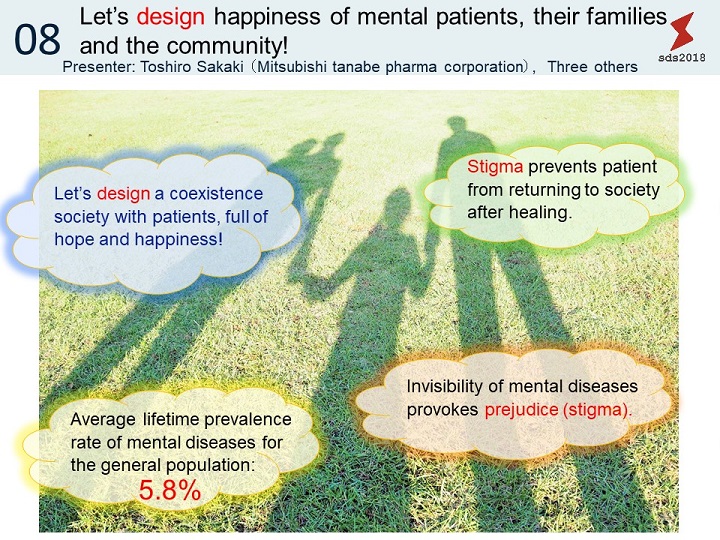Medicine treatment was presupposing for a business model of a conventional pharmaceutical company. We think the medical treatment in the future enters into the time when the solution for the patient’s UMN(Unmet Medical Needs, so it’s unsufficient) is demanded, with the concept of the around pill and also the beyond pill. To all participants, we expect creative opinions and want to have you open up the medical future with us.
| Name | Organization | Speciality |
|---|---|---|
| Toshirou Sakaki | Mitsubishi Tanabe Pharma Corporation Future Design Department | Digital technology, innovative drug development planning |
| Shinichi Kojima | Mitsubishi Tanabe Pharma Corporation Future Design Department | New business development |
| Hideaki Masui | Mitsubishi Tanabe Pharma Corporation Ikuyaku, Integrated Value Developement Division | Psychiatry and Neuroscience |
| Yurika Kino | Mitsubishi Tanabe Pharma Corporation Future Design Department | Psychiatry and Neuroscience |
Mental diseases increased rapidly from the late 90s, and it came to be called itself "5 biggest diseases" from 2011 by the stress caused by change of aging and the social structure. Seemingly it is said even to a healthy-looking person that 5.8% catch mental diseases throughout a lifetime. Also, it’s subdivision including the panic disorder, obsessive-compulsive disorder, post-traumatic stress disorder (PTSD) and so on advance and are the cause which complicates understanding by the commoner. There are many number of patients in these mental diseases with depression, schizophrenia, and anxiety disorders in turn.
For example, in schizophrenia, there are approximately 770,000 patients (2014, MHLW investigation) in Japan, and one of 100 have it including potentiality patients. In late years although it is said that effective drug therapies have developed, but a patient cancels to take medicine by their judgement, recurrence risk is held. The ratio of the inpatient also comes to 21.4% (ditto investigation) from reasons which are self-injury and other bruises, etc., and it also burdens the patient families heavily. A judgment of these diseases is difficult with the outward appearance, and there is a problem that understanding from the circumference is hard to be obtained. These prejudice (stigma) contribute to the obstruction of a social comeback after healing.
In this theme, we want all participants to take a posture which consider about a critical problem in mental diseases, assuming oneself or a close acquaintance to become a patient or their family. And more, we hope to design hapiness of patients, their families and community with you, by discussing the way of the society coexistence and taking a solution.
The following describes schizophrenia as an exsample of the mental diseases. In WS of the day, we appropriately switch to the mental diseases that a participant is easy to discuss and design the solution to social problem.
- The learning of basic knowledge of schizophrenia and deepen understanding.
- The acquisition of recognition and the understanding of the society problem to come from schizophrenia and mental diseases.
- Developmet of an ideality by the novel viewpoint without a stereotype. (especially about a stigma reduction plan to promote the patient’s social comeback)
- Needs excavation through reflected oneself to the patients and it’s family (insight work, persona setting)
- The acquisition of the skill to see into an essential problem
- Consideration power to embody an idea
- The mutal relations of patients, their families, healthcare workers, and local inhabitants is grasped through a patient journey map. UMNs from each viewpoint are investigated by insight work.
- Workaround plan of the problem in an extension of the present regimen is considered by backcasting.
- Ideas are visualized and arranged by paper-prototyping and it's dropped on a concrete plan.
【Design method】
- patient journey map, insight work, persona setting, brain storming, backcasting, prototyping
- Ice Break
- Lecture 1:Explanation on "mental diseases", systematically and clearly
- Lecture 2:"What is schizophrenia/depression? The problem that we have?" (as example)
- Choice of "the mental diseases theme":It’s discussed with a participant and fixed.
- Making of the patient journey map
- Backcasting:A problem is assumed by a current social security system and a real social system.
- A problem extraction from the social side by brain-storming (stigma reduction, early social comeback).
- Insightwork 1:Problem extraction from the viewpoint of patients and their families (mutual understanding)
- Insightwork 2:Problem extraction from healthcare workers (early consultation, in condition grasp)
- Discussion with Dr. Kawaguchi (Skype meeting)
- Discussion on the true happiness of the patients and their family (overall judgment)
- Decision of the concept
- Paper-prototyping: Rearrangement (visualization) of the solution
- The final confirmation of the report
- Presentation preparations(KRP)
- Presentation(KRP)
